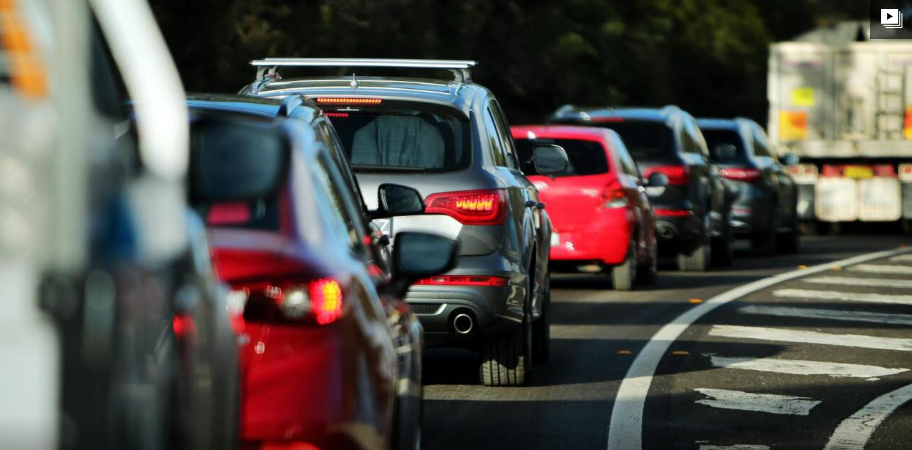US and European stocks slumped heavily overnight as concerns grow about the staggering new level of debt in America and skyrocketing lay offs.
American companies slashed more than 150,000 jobs last month – the biggest October total in more than two decades.
A report from layoff tracking firm Challenger, Gray & Christmas shows employers announced 153,074 job cuts in October, up 175 per cent from a year earlier and 183 per cent from September.
It marks the sharpest rise for the month since 2003, when the economy was rocked by the dot-com bust and widespread layoffs swept through Silicon Valley.
Investors around the world also appear to be worried about a wave of upcoming corporate results and the likelihood of another interest rate cut in the US.
The S&P 500 index of leading firms was down 1.1 per cent. The tech-heavy Nasdaq Composite fell 1.9 per cent.
After rising throughout the summer and early part of the fall, US stocks have been choppy in recent weeks as a government shutdown depletes investors of key updates on the economy.
“We are in a sense running out of catalysts right now to either support or propel stock prices,” said Sam Stovall of CFRA Research. “The market decided to take whatever profits it can and await additional news that could become encouraging once again.”
Investors and policymakers alike have been left in a fog as the government has delayed the release of key data on employment, trade, retail sales and others.
“Financial markets find themselves groping around in the dark,” said Chris Beauchamp, chief market analyst at investing and trading platform IG.

Wall St has slumped overnight.
Chicago Federal Reserve President Austan Goolsbee, who has been supportive of lowering interest rates, told CNBC in an interview that making cuts amidst a lack of data on inflation made him “uneasy.” With key economic data produced by the US government unavailable due to the shutdown, investors have been turning to private data sources.
A report by outplacement firm Challenger, Gray & Christmas said the number of layoff announcements in October hit the highest level in 22 years.
The report “painted a grim picture of the jobs market,” said Joe Mazzola, head trading and derivatives strategist at Charles Schwab brokerage.
The report found that this year has been the worst for layoffs since 2020, when the labor market was decimated by the pandemic, and that hiring has slowed to a 14-year low.
However the report “bolstered the case for a Federal Reserve rate cut in December despite Chairman Jerome Powell’s unexpectedly hawkish tone following the Fed meeting last month,” Mazzola added.
Investors were also digesting news that a majority of the US Supreme Court was skeptical about the legality behind a swath of Trump’s sweeping tariffs, which also lent support to equities.
“Is it good news? Paradoxically, not really,” said Swissquote Bank senior analyst Ipek Ozkardeskaya, who noted that the litigation means heightened uncertainty on international trade dynamics and how much tariff revenue will be available to the US Treasury.
Investors were also reacting to the Bank of England’s decision, in a tight vote, to keep its key interest rate unchanged before the UK’s Labor government presents its budget this month.
Weighing on European sentiment were some poorly received company earnings and official data that showed industrial production in Germany rebounded less than expected in September.
Shares in Franco-Dutch group Air France-KLM plunged more than 14 percent after it reported a drop in third-quarter net profit.
In New York, shares in chip-maker Qualcomm fell 3.6 percent despite a positive earnings report.
Tesla shares dropped 3.5 percent ahead of a vote by shareholders on a pay package for Elon Musk that could reach as much as $1 trillion.
US national debt has just passes $38 trillion
This all comes as America’s national debt has surged to unprecedented levels, with soaring interest payments now outweighing the gargantuan annual costs of Medicare and national defence.
Fringe analysts have pontificated and prophesied for years over the unstoppable rise in debt, which has now ticked past $38 trillion (AU$58 trillion). They have long pointed to a crisis that will never be fixed and will lead to a total collapse of the great 50 states.
Optimists have always had a leg to stand on in rebutting claims that the US would topple itself, pointing to an extremely strong tech sector and undeniable influence on global economic proceedings.
But the startling $38 trillion milestone shows just how dramatically America’s fiscal position has deteriorated.
Now, even mainstream economists, credit agencies, and policymakers are becoming alarmist over what the next decade might bring.
“Any great power that pursues a reckless fiscal policy by allowing the cost of its debt to exceed the cost of its armed services is opening itself up to challenge,” says economist Niall Ferguson.
“The US is just the latest great power to find itself in this fiscal jam.”
So how fast is it rising?
Well, just one day ago, the total was roughly US$38 billion less. It only passed the US$30 trillion mark in 2022.
It points to a system put under immense strain by rapidly increasing housing costs and general inflation, which has seen the average American take on more and more debt on average as each decade passes.
The run-of-the-mill American household now spends around $1,600 per month (A$2,470) on debt repayments alone. According to data from LendingTree and Experian, monthly obligations have climbed dramatically over the past decade. Car loan payments alone now average US$745 (around AU$1,150) per month in 2025, compared with roughly US$400 (about AU$620) ten years ago.
Although household incomes have grown modestly, higher interest rates and inflation mean that a greater share of family budgets is being consumed by debt servicing — leaving less room for savings, investment, and everyday essentials.

America’s national debt has surged to unprecedented levels, with soaring interest payments now outweighing the gargantuan annual costs of Medicare and national defence. Source: Fox News
The acceleration has also been fuelled by years of aggressive government spending under both Republican and Democratic administrations. Several economists now warn that the country’s fiscal trajectory is “bleak,” as persistent deficits and rising interest rates make the debt ever more difficult to manage.
“One can easily measure these signs of deterioration and see movement toward an impending debt crisis. Such a crisis occurs when the constriction of debt-financed spending happens, like a debt-induced economic heart attack,” says Ray Dalio, founder of Bridgewater Associates.
He went on to describe the current situation as a “death spiral” for the US.
“When you reach the part of the cycle that you have to borrow money to pay debt service, and the holders of those bonds say it’s a risky situation … In the private debt market, we call that the debt death spiral.”
Some say the debt crisis has been intensified by recent legislation, particularly Donald Trump’s One Big Beautiful Bill Act, which the Congressional Budget Office (CBO) estimates will add US$3.4 trillion to budget deficits over the next decade.
Trump’s team contends that new tariff revenues and stronger economic growth will offset those costs, though many economists remain sceptical.
The CBO’s latest projections assert that the national debt could reach US$54 trillion within ten years, largely driven by an ageing population, mounting healthcare costs, and higher interest rates.
“America’s fiscal outlook is more dangerous and daunting than ever, threatening our economy and the next generation,” Michael Peterson, CEO of the Peter G. Peterson Foundation, told Fox News this week.
“This is not the future any of us want, and it’s no way to run a great nation like ours.”
US already hit with ‘warning shot’
The unrelenting climb in debt levels has already prompted credit agencies to take action. In mid-2023, Fitch Ratings issued a surprise downgrade, cutting the US long-term credit rating from AAA to AA+, citing concerns over “the country’s deteriorating finances” and political gridlock.
“This is a warning shot across the US government’s bow that it needs to right its fiscal ship,” said Sean Snaith, an economist at the University of Central Florida.
Moody’s Ratings followed suit in May. The firm warned that the cost of interest payments is projected to soar from 9 per cent of federal revenue to 30 per cent by 2035.
“Successive U.S. administrations and Congress have failed to agree on measures to reverse the trend of large annual fiscal deficits and growing interest costs,” Moody’s wrote in its assessment.

The firm warned that the cost of interest payments is projected to soar from 9 per cent of federal revenue to 30 per cent by 2035.(Photo by Lionel BONAVENTURE / AFP)

Neither side of the US political fence can be solely blamed for the fiscal approach to ‘saving’ the nation from Covid. (Photo by ANTHONY WALLACE / AFP)
The C-word
Covid-19 naturally accelerated the crisis. Governments around the world were warned by then-shunned economists, who rallied against shutting down the system and propping it up with borrowed money.
They warned that the butterfly effect of pumping trillions into the system, essentially overnight, would be far too unpredictable and therefore too risky. The next decade, they argued, would be rife with inflation and a drop in living standards for the middle and lower classes.
Turkish economist Nouriel Roubini famously warned that the resulting Covid-19 recession could be even worse than the Great Depression of the 1930s.
But neither side of the US political fence can be solely blamed for the fiscal approach to “saving” the nation from Covid. The Trump administration’s pandemic response swelled the deficit by $3.1 trillion in fiscal 2020, the largest in US history. But then spending under Joe Biden also surged.
In less than two years in office, Biden approved roughly US$4.8 trillion in new borrowing, including $1.85 trillion for the American Rescue Plan and $370 billion for a bipartisan infrastructure package, according to the Committee for a Responsible Federal Budget (CRFB).
Higher interest rates, initially a response to inflation reaching a 40-year high in 2022, have also increased the cost of servicing the debt. The CBO warns that interest payments will become the fastest-growing part of the federal budget in the coming decades, rising from 3.1 per cent of GDP in 2024 to 5.3 per cent by 2054.
Beyond the numbers, the growing debt poses serious risks for the economy’s future and the prospects for the average middle-class citizen going forward.

In less than two years in office, Biden approved roughly US$4.8 trillion in new borrowing, including $1.85 trillion for the American Rescue Plan and $370 billion for a bipartisan infrastructure package, according to the Committee for a Responsible Federal Budget (CRFB). Photographer: Jim Watson/AFP/Bloomberg via Getty Images
A 2023 Pew Research Center survey found that 57 per cent of Americans now view reducing the budget deficit as a top priority, up from 45 per cent the year before.
The average American is more in tune with what the stakes are and appears to be placing more pressure on elected officials to steer the ship away from the rocks. But progress is slow as millions stare down the barrel of a future that looks less prosperous than the decades preceding.
The entire fiasco can almost be summed up in one sentence.
As more federal dollars are consumed by interest payments, less funding remains for essential priorities like education, infrastructure, and research … the very investments that fuel long-term growth.
“A nation saddled with debt will have less to invest in its own future,” the Peter G. Peterson Foundation wrote in a report.


Leave a Reply